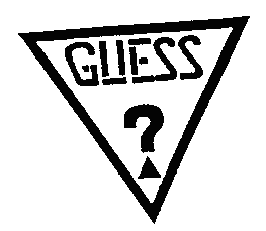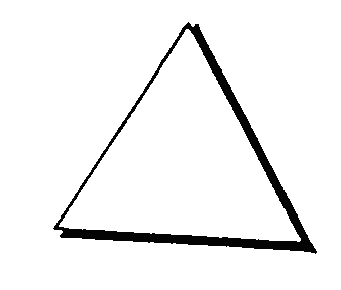Trademark Trial and Appeal Board
Patent and Trademark Office (P.T.O.)
*1 GUESS ?, INC.
v.
NATIONWIDE TIME, INC.
September 27, 1990
Opposition No. 78,773 to application Serial No. 690,800, filed October 20, 1987
Harris, Kern, Wallen & Tinsley, for Guess ?, Inc.
Meyer A. Gross, Stanley J. Yavner and Jay A. Bondell, for Nationwide Time, Inc.
Before Rice, Hanak and Hohein
Members
Member
Nationwide Time, Inc. (applicant) seeks registration of the triangle design shown below for "watches and straps for watches." [FN1]
Guess ?, Inc. (opposer) filed an amended notice of opposition setting forth three grounds on which to deny the application. First, opposer alleges that long before applicant's first use of its triangle design in 1987, opposer had made continuous use since 1984 of the composite mark shown below consisting of GUESS ? in an inverted triangle (herein after referred to as the "GUESS ? triangle").

Opposer further alleges that the contemporaneous use of the GUESS ? triangle for watches and clocks and applicant's triangle for watches and straps for watches is likely to result in confusion, mistake or deception. In this regard, opposer relies upon the rights which it derives from Registration No. 1,465,363 for the GUESS ? triangle for clocks and watches. This registration issued to opposer on November 17, 1987 with a claimed first use date of November 1984. Second, opposer alleges that applicant's triangle design is a common geometric shape which is not inherently distinctive, and that this purported mark should be refused registration because applicant has failed to show that it has become distinctive of applicant's goods. Third, opposer alleges that applicant is not entitled to registration because applicant failed to make use of its "mark" prior to the filing date of its application (October 20, 1987).
Applicant denied the foregoing allegations. Both parties filed briefs after trial. Neither party requested an oral hearing.
We will consider the three grounds set forth in the amended notice of opposition in reverse order. Opposer's claim that applicant failed to make use of its triangle design prior to the application filing date can be quickly disposed of in applicant's favor. Not only is there no evidence in the record to support opposer's claim, but in addition, opposer's counsel, along with applicant's counsel, signed a Stipulation of Facts for Applicant's Case which contained, among other things, the following statement: "Applicant has continuously used the Pyramid [Triangle] Design trademark in connection with the advertising and sale in commerce of watches and watch bands since August 18, 1987." Thus, opposer has conceded that applicant made continuous use of its triangle or pyramid design for at least two months before its application filing date of October 20, 1987.
We will next consider opposer's claim that applicant's triangle design is a common geometric shape which is not inherently distinctive, and that applicant has failed to show that its triangle design has become distinctive of applicant's watches and watch straps. It is noted that applicant did not seek to register its mark pursuant to Section 2(f) of the Lanham Trademark Act (15 U.S.C. 1052f). That is to say, the Examining Attorney who handled applicant's application did not consider that applicant's triangle design was nondistinctive. Applicant was not required during the examination phase to show that its triangle design had become distinctive of its watches and watch bands. Therefore, opposer has the burden of going forward and showing that applicant's triangle design lacks inherent distinctiveness. Yamaha International v. Hoshino Gakki, 840 F.2d 1572, 6 USPQ2d 1001, 1005 (Fed.Cir.1988).
*2 However, opposer's burden of going forward in this particular case is a rather easy one because applicant's "mark" consists of a very basic geometric shape, namely, an equilateral triangle. [FN2] In re David Crystal, Inc., 296 F.2d 771, 132 USPQ 1, 2 (CCPA 1961) ("But unless the design is of such nature that its distinctiveness is obvious, convincing evidence must be forthcoming to prove that in fact the purchasing public does recognize the design as a trademark...."); Seabrook Foods, Inc. v. Bar-Well Foods Ltd., 568 F.2d 1342, 196 USPQ 289, 291 (CCPA 1977) ("In determining whether a design is arbitrary or distinctive this court has looked to whether it was a 'common' basic shape or design ..."); Brooks Shoe Manufacturing Co., Inc. v. Suave Shoe Corp., 716 F.2d 854, 221 USPQ 536, 538-39 (11th Cir.1983) ("Such a basic geometric shape [a 'V'] generally is not considered inherently distinctive.").
Applicant argues that the rule that common basic shapes are considered inherently nondistinctive is applicable only when such common basic shapes are used "as a vehicle or background for the display of word marks, [and not] to the situation [as is the case here] in which the design, by itself, is used as a mark." (Applicant's brief page 5, emphasis in original). Applicant has provided no authority for the proposition that simple geometric shapes (such as circles, squares and equilateral triangles) should, when used by themselves, be regarded as inherently distinctive. It simply makes no sense to say that an equilateral triangle, when used in association with a word, is inherently non-distinctive, and then to say that an equilateral triangle, when used by itself, is inherently distinctive. It is clear that "ordinary geometric shapes such as circles, ovals, squares, etc., even when not used as a background for other marks, are regarded as non-distinctive and protectable only upon proof of secondary meaning." 1 J. McCarthy, Trademarks and Unfair Competition, Section 7:12 at pages 206-207 (2d ed. 1984) (emphasis added). See also Wiley v. American Greetings Corp., 762 F.2d 139, 226 USPQ 101, 103 (1st Cir.1985) ( "[A] red heart is a 'common' basic shape, similar to a geometrical design. It is hornbook law that 'ordinary geometric shapes such as circles, ovals, squares, etc., even when not used as background for other marks, are regarded as non-distinctive and protectable only upon proof of secondary meaning.' [citing McCarthy]." [FN3]
Given the fact that applicant's equilateral triangle design is inherently nondistinctive, it is entitled to registration only upon a showing by the applicant that it has become distinctive of applicant's watches and watch straps. We find that applicant's showing of acquired distinctiveness is inadequate. Applicant has shown that sales of watches and watch straps bearing its equilateral triangle or pyramid design have been less than $4 million. Moreover, while applicant has established that it advertised its products on the wholesale level in a trade magazine called National Jeweler, it has not shown the extent to which it has advertised on the wholesale level, nor has it shown that it has done any advertising on the retail level. In contrast, opposer has shown that since 1984, sales of watches bearing its GUESS ? triangle design have exceeded $87 million at wholesale and $160 million at retail. Moreover, opposer has shown that it has spent in excess of $3 million in advertising watches bearing the GUESS ? triangle in such periodicals as GO, Cosmopolitan, Glamour, Fame, Traveler, and Elle. Thus, if an equilateral triangle has become distinctive of anyone's watches, it has, if anything, become distinctive of opposer's watches. [FN4]
*3 Turning to a consideration of the issue of likelihood of confusion, we find that while both opposer's GUESS ? triangle design and applicant's triangle or pyramid design are used on identical goods, that nevertheless there is no likelihood of confusion inasmuch as the only similarity between them is a common basic shape, namely, an equilateral triangle. It has been noted many times that "common basic shapes such as circles, diamonds, triangles, squares, ovals, arrows and the like have been so commonly adopted as marks or as a part of marks for a variety of products in a variety of fields that whatever rights one possesses in such a design are confined to the particular design and cannot serve to preclude the subsequent registration of a similar yet readily distinguishable design for the same or similar goods." Hupp Corp. v. AER Corp., 157 USPQ 537, 540 (TTAB 1968). 1 J. McCarthy, Trademarks and Unfair Competition, Sections 7:12 and 7:13 at pages 206 to 208 (2d ed. 1984) ("...[S]imple geometric shapes, even if given protection, are accorded a narrow scope of trademark or unfair competition protection, both as to scope of product and to variation in design.")
Decision: The opposition is sustained on the basis that applicant's equilateral triangle design is inherently nondistinctive and applicant has failed to show that its design has become distinctive in the sense that it primarily indicates watches and watch straps emanating from applicant.
J. E. Rice
E. W. Hanak
G. D. Hohein
Members, Trademark Trial and Appeal Board
FN1. Application Serial No. 690,800 filed October 20, 1987 claiming first use on August 18, 1987.
FN2. We find that the slight shading or thickening of two of the three sides of applicant's equilateral triangle does not render it inherently distinctive.
FN3. It should be noted that in the David Crystal case and in the Brooks Shoes case the common designs held to be inherently non-distinctive were used by themselves, and were not used as backgrounds for word marks or in association with word marks.
FN4. To be clear, we are not making any determination as to whether an equilateral triangle has become distinctive of opposer's watches.


